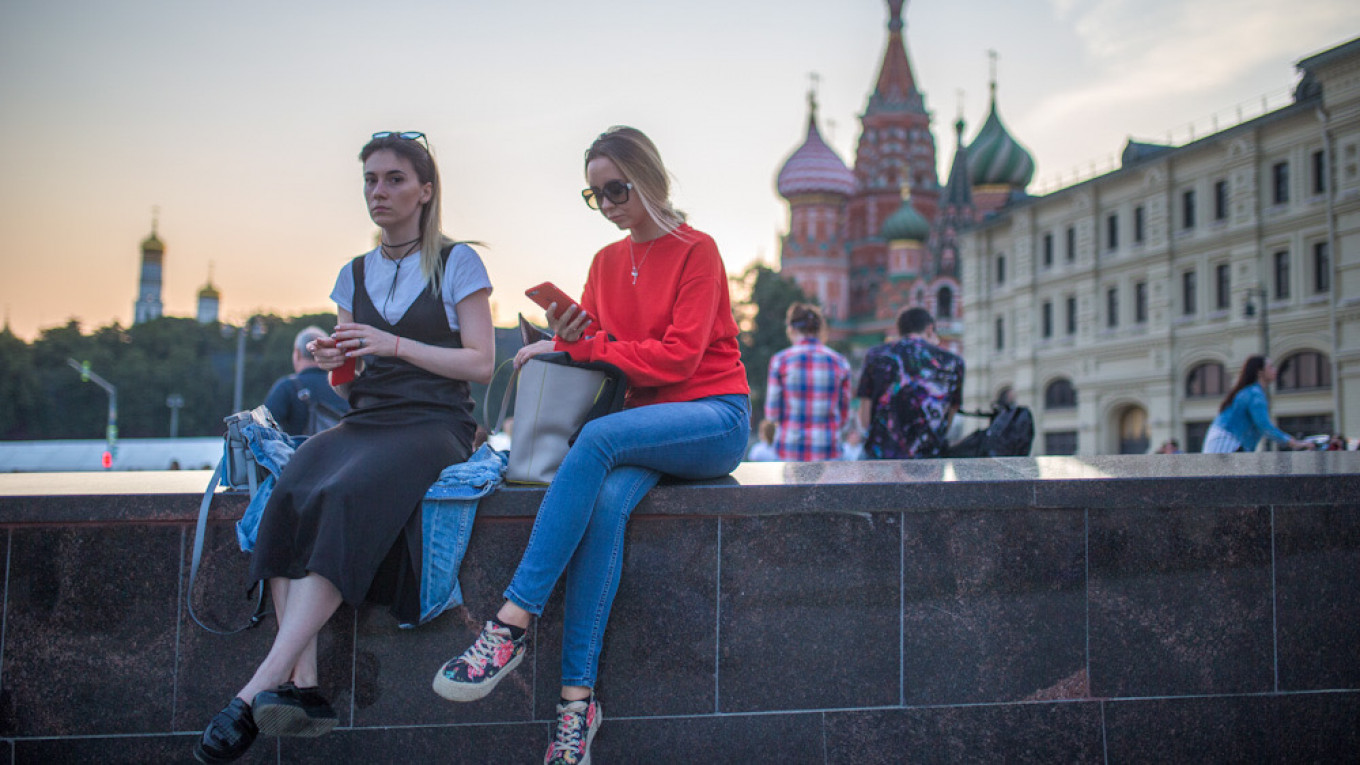Amid the deluge of online disinformation during the coronavirus pandemic, geopolitical tensions pitting China and Russia against the West have continued to ratchet up, especially in the digital domain.
Russian information operations have drawn greater attention in the West since the 2016 U.S. presidential election, and many analysts have seen echoes of such online trolling and disinformation in the more assertive, confrontational posture of Chinese diplomats on social media during the coronavirus pandemic.
Russian and Chinese propagandists also seem to be mirroring each other’s tactics and cross-promoting each other’s content, leading some Western analysts and governments to warn of deepening digital cooperation between Moscow and Beijing.
China and Russia do indeed share a lot of strategic objectives, and their partnership has been deepening across the board since the 2014 outbreak of war in Ukraine and Western sanctions against Moscow.
After all, both countries’ leaders decry U.S. hegemony and see the United States and its alliances as challenges to their national security and national interests. And both Chinese and Russian policymakers are striving to exploit existing fissures in Western societies while weakening ties between the United States and its allies through information operations and other means.
Furthermore, both the Kremlin and Zhongnanhai are intent on defusing Western criticisms of (and perceived designs to topple) their political regimes, while advancing their own self-serving, government-friendly narratives. Beyond these commonly held strategic objectives, both countries have drawn tactically on their own histories while also learning from one another and others.
While increasingly compatible shared goals seem poised to unite Beijing’s and Moscow’s exploits in the digital domain and foretell future cooperation, the two countries have not reached that point just yet. Similarities between Chinese and Russian online behavior are largely the result of Chinese actors’ careful but independent study of and creative adaptations of the Kremlin’s tools, rather than an expression of active, ongoing cooperation between the two governments.
Although future cooperation can hardly be ruled out, there are notable barriers that will likely continue to complicate the two sides’ ability to work together on information operations in the near to medium term.
When deciphering the similarities between the techniques of Russian and Chinese information operations, it is important to note two common sources of inspiration. The first is the set of techniques both countries use to quell domestic dissent online and to amplify pro-government messages. Armies of bots have been developed and deployed by Moscow and Beijing in recent years independently of each other for these purposes. More recently, these bots have been adapted and repurposed to conduct information and influence operations on the global stage with varying degrees of success.
The second source of inspiration is the public diplomacy strategy developed by the United States during former president Barack Obama’s first term. Research interviews reveal that both Russia and China carefully studied the toolbox of U.S. digital diplomacy and adapted it simultaneously — yet independently—of each other.
The use of troll farms, long used to intimidate and drown out online critics of Russian President Vladimir Putin’s regime, is now a common and well-documented feature of information operations against foreign targets.
The notorious Internet Research Agency and similar troll farms operated by Kremlin proxies have been harassing the Russian opposition and pushing pro-Kremlin narratives on Russian social media for the past decade. This part of the Russian government’s arsenal has been deployed in numerous foreign contexts since the 2016 U.S. presidential campaign.
Beijing has its own army of online trolls, which was built independently of Moscow’s and in fact predates the Russian analogue as a tool for attacking online voices of dissent. Pro-government online activists in China pushing pro-regime narratives (known as the so-called 50 Cent Party) have been a permanent feature of Chinese online culture since the 1990s. Amid tightening internet regulations and other moves to limit the online presence of dissidents, Chinese pro-regime activists have long been tasked with advancing narratives glorifying government policies.
Some Chinese online activists have also clashed with supporters of Taiwan and overseas Chinese diaspora communities in online forums and on social media networks on several issues, including China’s human rights record. The storm of pro-Beijing online comments currently on display in every China-related discussion on platforms like Twitter or Facebook has its roots in these earlier tactics, though these techniques have now been taken to a whole new level thanks to modern technology.
The other source of inspiration for both Russia and China is Obama-era U.S. digital diplomacy, particularly the use of Twitter and other social media platforms by American diplomats. Russian officials carefully studied these online practices of promoting U.S. interests and views abroad through Twitter, YouTube, Facebook, and other platforms, as well as the engagement of U.S. embassies with civil society and mass audiences in their host countries through social media. In the United States, the deployment of social media as a tool for public diplomacy was orchestrated by Alec Ross, a senior adviser on innovation to then secretary of state Hillary Clinton. In the Russian Foreign Ministry, this approach was pioneered by officials like Alexander Yakovenko and Maria Zakharova. Yakovenko was serving as the Russian ambassador to the UK at the time and was the main person behind the Russian Embassy’s caustic Twitter account; meanwhile, Zakharova was then serving as deputy director of the ministry’s Department for Information and Press. (Yakovenko was Zakharova’s mentor at the ministry: she worked under his direct supervision from 2003 to 2005.)
Natalya Timakova, the spokeswoman for then president Dmitry Medvedev (an active Twitter user himself), has also supported the digitalization of Russian global messaging and proactive use of social media.
During a July 2012 meeting with senior Russian diplomats, Putin, who had just returned to the Kremlin after a four-year stint as prime minister, ordered the Ministry of Foreign Affairs to improve its “use of new technologies including soft power [tools].” Since then, the online presence of the ministry, including embassies and senior diplomats, has boomed. A group of senior officials led by Putin spokesman Dmitry Peskov has developed recommendations on boosting Russian influence abroad, including through the active use of social media by the diplomatic corps and Russian state-run media aimed at foreign audiences, like RT and Sputnik.
China’s active use of Twitter and Facebook for public diplomacy started several years later in 2019. According to BBC estimates, Chinese individual diplomats and embassies started opening Twitter accounts in 2010, but before 2019, the number of such accounts was in the low double digits. In 2019, the Chinese Ministry of Foreign Affairs set up thirty-two accounts, including an official account for its spokesperson, (which has links to the ministry’s pages on YouTube, Facebook, and Instagram). The move to dramatically expand China’s official online presence was taken amid growing concerns in Beijing about an incipient new era of across-the-board competition with the United States. The decision to start coordinated active pushback against Washington and its allies on social media platforms was inspired by the Twitter diplomacy of then U.S. president Donald Trump and his senior team during the trade war with China.
Some Chinese diplomats used Twitter before 2019 and were assertive on the platform, defending China’s favored narratives or engaging in whataboutism. (The most famous example is a 2019 spat on Twitter between Zhao Lijian, the ministry’s deputy spokesperson, and former U.S. national security adviser Susan Rice). Yet this “wolf warrior” rhetoric, which takes its name from a patriotic Chinese blockbuster movie, has never been formally endorsed by senior Chinese leaders. Before 2019, the Chinese leadership was more orthodox in following the established practices of traditional diplomacy. For the most part, Beijing maintained a clear line between the usually reserved tone of Chinese diplomats and the more bombastic and assertive tone of state-run media, particularly English-language outlets like the Global Times that excelled at delivering angry messages to the outside world.
Even before the Trump era, Beijing had evaluated more proactive use of social media platforms to go on the offensive. In addition to studying Western models of public diplomacy and the role of leading global media brands like the BBC or CNN, Chinese leaders also specifically examined the practices of their Russian colleagues. Several internal Chinese government studies examined the modus operandi of Russian state-run channels and news agencies aimed at foreign audiences. These studies sought to identify international best practices to improve engagement with international audiences by the Xinhua News Agency, the Chinese Global Television Network (CGTN), and other state-run Chinese media that produce content in foreign languages. Internal analytical pieces were also produced by state-linked research organizations operated by the Ministry of State Security and the CCP Propaganda Department. They reportedly looked into the experience of Russian international media outlets, as well as the digitalization of the Russian diplomatic corps.
These internal documents represent the tip of the iceberg of Chinese analytical interest in Russian tools of strategic communications. Traces of this interest among Chinese officials and the country’s analytical community are visible in open sources. For example, a search through the China National Knowledge Infrastructure (CNKI), a database of mainland Chinese academic journals, identifies 116 articles with the terms “Russia Today” or “RT” in the headline.
The first academic article was published in 2013, and the body of publicly available research on RT alone has been growing ever since. Considerable information on Russia’s use of information and influence operations in Western countries has been publicized in recent years by Western governments, most notably by the team of former U.S. special counsel Robert Mueller and the U.S. Senate Select Committee on Intelligence. Notably, the CNKI features no publicly available studies of Russian interference in U.S. elections published by Chinese academics.
In short, China’s approach to information operations is still taking shape, but the elements of this approach stem from various sources. Chinese methods bear some resemblance to the Russian playbook (which itself is full of creative borrowing from other countries, most notably the United States), U.S. digital diplomacy, and the CCP’s own communications tactics aimed at domestic internet users.
Yet an important question remains. If the Chinese approach to strategic communications provides little evidence over the last two years of active cooperation with Russia, then are Beijing and Moscow likely to work together on online information operations going forward?
Dialogue between Russian and Chinese officials on cooperation in the information sphere has been ongoing for several years. While the details of such discussions seldom become public, Russian officials have occasionally sought to play them up in ways that support the Kremlin’s broader narratives or to curry favor with Beijing.
To cite one example, in October 2019, Zakharova (who by now had become the spokesperson of the entire Russian Ministry of Foreign Affairs) met with her Chinese counterpart, Hua Chunying, in Beijing to exchange views on the “current international situation, and press and media cooperation between the two Foreign Ministries.” Zakharova had told reporters two months earlier that the two countries would hold consultations on meddling by Western intelligence services in Russian and Chinese domestic politics following protests in Moscow and Hong Kong.
Zakharova told Russian media that she and her Chinese colleague had presented their research findings and come to the joint conclusion that the West, led by the United States and other members of the North Atlantic Treaty Organization, was indeed interfering.
Since 2014, Russian and Chinese state-run media have signed several agreements. Russia’s Sputnik News and the China Media Group (CMG) are the most visible and important players. (The CMG includes CCTV, Chinese National Radio, and Chinese Radio International.) In 2018, Sputnik and the CMG signed a cooperation agreement focused on content sharing and joint projects. Sputnik previously had similar agreements with other Chinese media outlets (including the Xinhua News Agency, Chinese Radio International, and the Global Times), but since the CMG’s emergence as a leading international media holding in China, the company has become the prime interlocutor on the Chinese side. The respective heads of Sputnik News and the CMG—Dmitry Kiselyov and Shen Haixiong (who is also deputy director of the CCP’s Propaganda Department)—co-chair the Media Council of the Russia-China Peace, Friendship, and Development Committee. Despite the fanfare, the 2018 agreement remains limited to bilateral exchanges of content, with CMG materials about China appearing on Sputnik News platforms in Russian and vice versa. According to numerous interviews, people working in state propaganda systems on both sides describe the agreement as largely symbolic and formalistic, with a particular focus on highlighting standard government narratives about China-Russia relations reaching the “highest level of cooperation in history.” More importantly, these agreements target domestic audiences and do not include joint projects aimed at global audiences.
There is also a government-level subcommittee for cooperation between Chinese and Russian national media actors that falls under the purview of the Russia-China Intergovernmental Commission on Humanitarian Cooperation. The commission is co-chaired by officials at the level of deputy prime minister, while the subcommittee on media is chaired by deputy ministers of communication.
Its metrics of success center on the number of joint events, joint seminars, and joint publications. However, this subcommittee deals with bilateral cooperation between Russian and Chinese media actors for domestic audiences, not foreign ones.
Finally, since 2015, Russia and China have held annual media forums co-hosted by the CCP Propaganda Department and the Russian Presidential Administration. The first forum was held in Saint Petersburg in June 2015, and the latest event in 2020 took place online. Official readouts of past forums focus on reciting official pronouncements of cooperation. No joint work on social media platforms is mentioned. According to interviews with forum participants, the workflow is extremely formalized and limited to the exchange of familiar talking points by state media bigwigs.
Apparently, any conversation of practical steps toward working together on international platforms is limited at best.
If official platforms for China-Russia media cooperation are more about form than substance, and if existing agreements between state-owned media are aimed at domestic audiences, why is the news coverage that RT and CGTN produce for global audiences so similar? There are multiple factors at play here. First, a great many of the negative reports about the West that are produced by Russian and Chinese state media are for domestic audiences. This coverage is part of a long-standing strategy to emphasize that the major adversaries of Moscow and Beijing are mired in domestic problems even as the authoritarian regimes of Putin and Chinese President Xi Jinping are delivering stability. In addition, two major state-run news outlets in Russia and China (Rossiya Segodnya and CMG, respectively) rely on combined teams to produce content for domestic audiences and overseas markets. The senior managers directing editorial policy for domestic and foreign coverage are the same people, so many of the stories about the declining West or the rise of Russia and China are simply packaged differently for domestic and overseas audiences yet selected by the same people using the same criteria.
Finally, overlapping narratives pushed by both Russia and China in the global information domain can be used to achieve different, albeit sometimes complementary, policy goals. For example, Moscow has falsely accused U.S.-funded biological labs outfitted to detect disease outbreaks in former Soviet states in Central Asia and the Caucasus of being involved in the production of biological weapons and perhaps the creation of the strain of coronavirus that causes COVID-19. Parts of this narrative are roughly a decade old and have been pushed largely through Russian domestic media channels.
The most senior promoter of this narrative is Nikolai Patrushev, secretary of the Russian Security Council, who regularly voices concerns about U.S. bioweapons labs. He spoke on the topic at length in an pre-pandemic interview with Rossiyskaya Gazeta in January 2019 and most recently in an April 2021 interview with Kommersant. This Russian narrative has been picked up during the pandemic by Chinese officials (including the aforementioned Zhao) and Chinese English-language media. The narrative is a convenient way to push back against calls for a more transparent investigation into the origins of the pandemic and change the subject. It is hard to say whether Patrushev and Zhao’s actions were coordinated in advance or whether Chinese actors are simply borrowing the Russia-developed narrative for their own purposes.
Despite all these signs of nascent support and shared goals, it would be a mistake to overstate the degree to which Moscow’s and Beijing’s propaganda machines are actively working in tandem at present. Still, it is worth asking whether Chinese and Russian propagandists may do so more effectively in the future. Although such an outcome cannot be ruled out entirely, there are significant practical obstacles to closer China-Russia cooperation in this arena.
The first limiting factor is the level of trust between the two sides’ security and intelligence establishments. Information about the planning, methods, and operational details of information and influence operations in both countries are, by definition, sensitive matters. Sharing such information would require a high-ranking political decision as would any move toward jointly planned and executed operations.
All of that would require an enormous amount of trust and unity of purpose, which is still lacking.
In many respects, such moves would mean that China and Russia are ready to move toward creating a de facto alliance — a prospect that Moscow and Beijing have constantly denied. Following a final agreement on their territorial dispute in 2004, Moscow and Beijing have carefully downplayed each side’s threat perceptions, intelligence activities, and other sources of mutual suspicion as a hallmark of improved ties between the countries.
However, since 2020, there have been signs that the Russian security establishment is becoming more worried about aggressive Chinese intelligence gathering in Russia and is starting to send signals of displeasure to its counterparts in Beijing.
Such signs of unease suggest that it may be difficult for Moscow and Beijing to move aggressively toward deeper engagement and active cooperation in areas such as disinformation and influence operations.
Either way, these are the types of activities that no country ever admits publicly so it would be hard to know for sure if the mood in the two capitals ever changes enough to allow greater collaboration.
Russian and Chinese state propagandists also lack practical experience in working together. So far, the two countries’ state-run media outlets have not developed enough interoperability to produce decent materials for distribution in either Russia or China.
According to interviewees, Russian journalists working at Chinese media organizations like the Xinhua News Agency and CGTN point to differences in work cultures as a major obstacle. They complain that their experience is ignored by their Chinese supervisors, even when it comes to the issue of packaging Chinese content for Russian audiences. Issues of control and seniority are likely to seriously constrain any efforts to build a joint Chinese-Russian team for conducting information operations.
As in many aspects of China-Russia relations, there is growing asymmetry in how the two countries support each other on the global stage. Since 2019, Russian officials have frequently voiced support for China in its confrontation with the United States. For example, Putin declared in 2019 that sanctions against Huawei were an example of U.S. economic warfare and were driven by a desire to kill off a strong competitor. Similarly, at the 2020 Munich Security Conference, Russian Foreign Minister Sergey Lavrov publicly backed China’s handling of the pandemic, and the Russian Ministry of Foreign Affairs has pushed back numerous times against Western calls for an independent inquiry into the early stages of the public health crisis in the Chinese city of Wuhan.
Chinese officials, however, are often in no rush to return the favor. Examples of unequivocal Chinese support for the Kremlin’s stance on issues in which China does not have a direct stake are rare. Most of the time, Beijing stakes out a neutral position as it did on issues like Crimea’s status, the war in Donbas, and the poisoning of the former Russian intelligence officer Sergei Skripal in the UK. When confronted by reporters during press briefings, Chinese diplomats are typically reserved and rarely voice support for Russia. At the same time, Moscow does not publicly support Beijing on issues over which Russian and Chinese interests diverge.
For example, the Kremlin has not taken China’s side in territorial disputes with countries like India, Japan, and Vietnam: all of them are important regional partners for Moscow in their own right.
Shared goals yet constrained cooperation
At root, both Russian and Chinese leaders are driven by great power calculus. Therefore, they want to maintain strategic autonomy above all else, including in pushing back against the United States and its allies. Rhetorical support from a like-minded great power is nice to have, but it is not indispensable when it comes to the global information domain, an area unregulated by international legal norms.
On the UN Security Council, by contrast, Moscow and Beijing frequently act far more in tandem because of the bureaucratic nature of the organization and both countries’ unique position as permanent members. For now, however, Chinese and Russian influence operations can be — and continue to be — conducted independently.
This article was first published by the Carnegie Moscow Center.
A Message from The Moscow Times:
Dear readers,
We are facing unprecedented challenges. Russia's Prosecutor General's Office has designated The Moscow Times as an "undesirable" organization, criminalizing our work and putting our staff at risk of prosecution. This follows our earlier unjust labeling as a "foreign agent."
These actions are direct attempts to silence independent journalism in Russia. The authorities claim our work "discredits the decisions of the Russian leadership." We see things differently: we strive to provide accurate, unbiased reporting on Russia.
We, the journalists of The Moscow Times, refuse to be silenced. But to continue our work, we need your help.
Your support, no matter how small, makes a world of difference. If you can, please support us monthly starting from just $2. It's quick to set up, and every contribution makes a significant impact.
By supporting The Moscow Times, you're defending open, independent journalism in the face of repression. Thank you for standing with us.
Remind me later.








